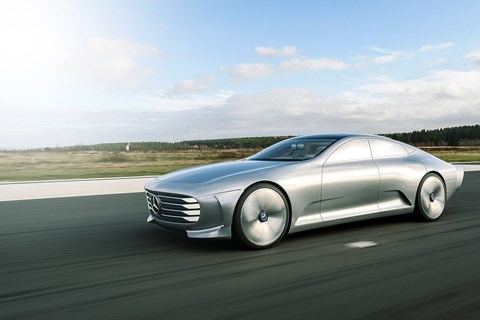► We drive the crazy Mercedes Concept IAA
► A shape-shifting, low-drag, futuristic being
► This is the future? We’re in!
Concept IAA is a one-off prototype, a show car, but it is also a proper runner. Under the mildly outrageous bodywork – a CAD/CAM-generated, milled-from-solid, big-money styling statement – the drive-train is straight out of the C350e plug-in hybrid, the chassis an improvised parts bin compilation.
Why does it exist? To showcase Mercedes’ latest design (interior and exterior), propulsion and aero thinking, and in some style. This is a futuristic yet strangely mature family car, one that leaves a lasting impression, not least because, unmissable extending rump aside (preposterous, you might think, until you consider the benefits, and even then…) there’s much here that will see production, and that we’re now impatient for.
The most spectacular function of the car’s body is the extending Kamm tail rear end, which grows by up to 390mm at speeds in excess of 50mph to make a more aerodynamically efficient teardrop shape of the car’s silhouette. Up front, two lateral flaps also swing out to direct air past the wheelhouses and along the flanks of the vehicle. An adjustable horizontal deflector also varies its angle of attack to smooth the underbody airflow. Very clever and relatively affordable is the adaptive wheel design, which uses five spring-loaded metal elements to change the shape from dished to flush-fitting.
The main virtue of all this magic morphing is a staggeringly low drag coefficient of 0.19, allegedly a new world record for a fully functional four-door saloon. That’s an improvement of 0.6 over the car in its at-rest, high-drag form, and Mercedes claims there are no downsides: no unfortunate payoff in reduced downforce, increased sensitivity to crosswinds, compromised aero balance or compromised directional stability.
In addition, the low-drag stance reduces CO2 emissions from 31g/km to 28, while also extending car’s zero emission/pure electric range from 38.5 to 41 miles. Believers swear you can hear the reduced headwind resistance as the car changes shape, and physically feel the more slippery aero. Let’s find out.
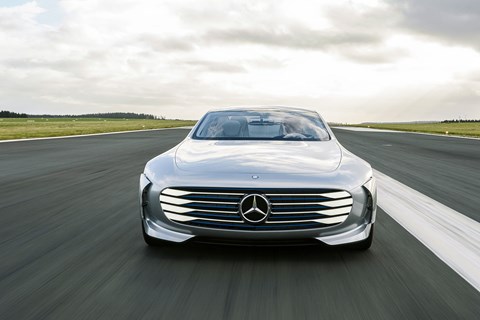
Today, at speeds of up to 60mph and on hand-carved quasi-slicks despite near-freezing temperatures and a persistent drizzle, car and driver are surrounded by an entourage of 13 engineers, mechanics, photographers, video cameramen, press people and cleaners. Thankfully the door opening is wide enough not to get stuck climbing in. Concept IAA’s cockpit is much closer to production reality than its space-age shape.
With the exception of the technicolour air vents and some surface materials, this layout accurately previews the instrument panel of the next E-class. What looks at first glance like a tweaked S-class interior is in fact a cockpit revolution dubbed OFN for optical finger navigation. So no touchscreen, no gesture control and not even an iteration of the good old Comand controller – the only leftovers are the two large monitors, the square trackpad, the voice control button and the optional head-up display. Now your thumbs are all it takes to execute every single OFN function.
To the smartphone generation, operating the two control pads in the steering-wheel spokes will be as intuitive as cracking open a can of Red Bull. Even this father of two adolescents finds it surprisingly easy to scroll through menus and sub-menus with his fingertips. Haptic responsibilities are clearly divided, with movements of your right paw reflected by the right-hand in-dash display (infotainment, navigation, media and connectivity) while your left thumb connects to the left-hand monitor, responsible for car functions such as assistance systems.
As soon as the digit has done its job, one push at the confirmation button in the middle of the touchpad suffices to place your order. Got it wrong? Hit the silver return bar and the black box will automatically take you back to the previous level. It sounds complex but OFN works really well, especially in combination with the optional head-up display. Says Thomas Weber, board member in charge of r&d: ‘Hands on the steering wheel, eyes on the road. There is no safer way to stay on top of the fast growing ergonomic complexity.’
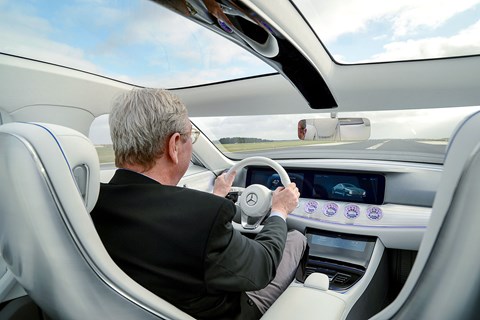
Head- and legroom are surprisingly generous, the perfectly comfortable seats are adjustable via Merc’s trademark in-door controls and the trackpad on the transmission tunnel feels familiar. If it wasn’t for the red-light district window treatment, visibility would be truly panoramic.
The brightness of the cabin is intensified by the white leather upholstery, the brushed aluminium dashboard and the double-bubble glass roof. Pull the door of the sculpted starship shut and, through the screened and tinted side windows, onlookers are reduced to silhouettes. Some of the faces appear worried but after one last laptop check it’s a thumbs up.
One nudge on the generic stalk-operated shifter gets us going; slowly, silently. Press the pedal harder and the whisper-liner’s voice changes tone, from lullabye to baritone, as the 2.0-litre turbocharged four kicks in to help summon a combined 279bhp and a beefy 442lb ft of torque. Moments later a subtle support choir joins in as motors effect the changes into low-drag aerodynamic mode. Can I feel the difference? I can. Lifting off a fraction brings about no discernible loss of speed, while the car also free-wheels further when I back off the throttle completely.
When will these kind of features see light on a production car I ask Gorden Wagener: ‘It’ll be a while,’ says the chief designer. ‘Right now, legislation does not even allow door mirrors to be substituted by cameras, which would make a big difference. Changing the outline of a vehicle in motion is bound to be an even taller hurdle. But we must keep working on it because besides weight and propulsion, first-class aerodynamics are prime efficiency drivers.’
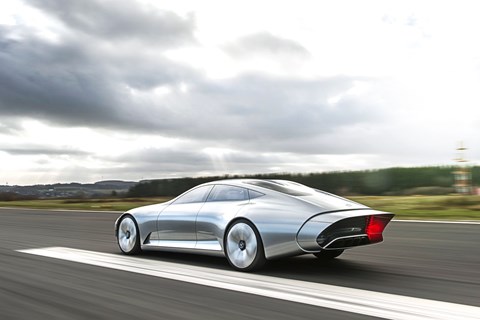
The third message relayed by Concept IAA is Mercedes’ Electric Vehicle Architecture (EVA), set to come to market in four steps: ELC is a rebodied GLC-based BEV (2018); ELA a variant of the next-gen GLA powered by the same drivetrain as the electric B-class (2019); EVA 1 is the smaller version of an all-new bespoke BEV matrix positioned below the E-class (saloon and crossover, 2020); and EVA 2 is its larger equivalent positioned below the S-class (2022).
According to those in the know, the face of Concept IAA will likely become the signature look for all future zero-emission Benzes. Likely carryover elements include the sharknose front, the tapered rear and the unmistakable headlight/taillight graphics. While plug-in passenger cars may feature only three horizontal LED bars, SUVs could stack four or five. No, there will be no changes to the three-pointed star – at Mercedes, they don’t mess with brand icons.
Up against
Better than: Mercedes-Benz Bionic concept – Fish-inspired aero-box a damp squib
Worse than: Eagle E-type Low Drag Coupe – Eco-friendly shape let down by raging 345bhp straight-six
We’d buy: VW XL1 – Ice cool 795kg fuel-sipper
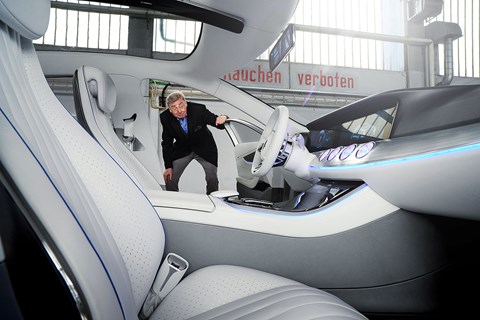
The specs: Mercedes-Benz Concept IAA
Price: n/a
Engine: 1991cc turbo 4-cyl plus 6.2kWh e-motor, 275bhp (combined), 442lb ft (combined)
Transmission: seven-speed auto, rear-wheel drive
Performance: 5.8sec 0-62mph (est), 155mph (est), 191.6mpg, 28g/km CO2
On sale: In a little while…
Love: Outlandish styling, MMI, morphing wheels
Hate: That it’s not on sale just yet…
Verdict: Cool, clever and resolved concept
Rating: ****
Read more CAR magazine reviews
